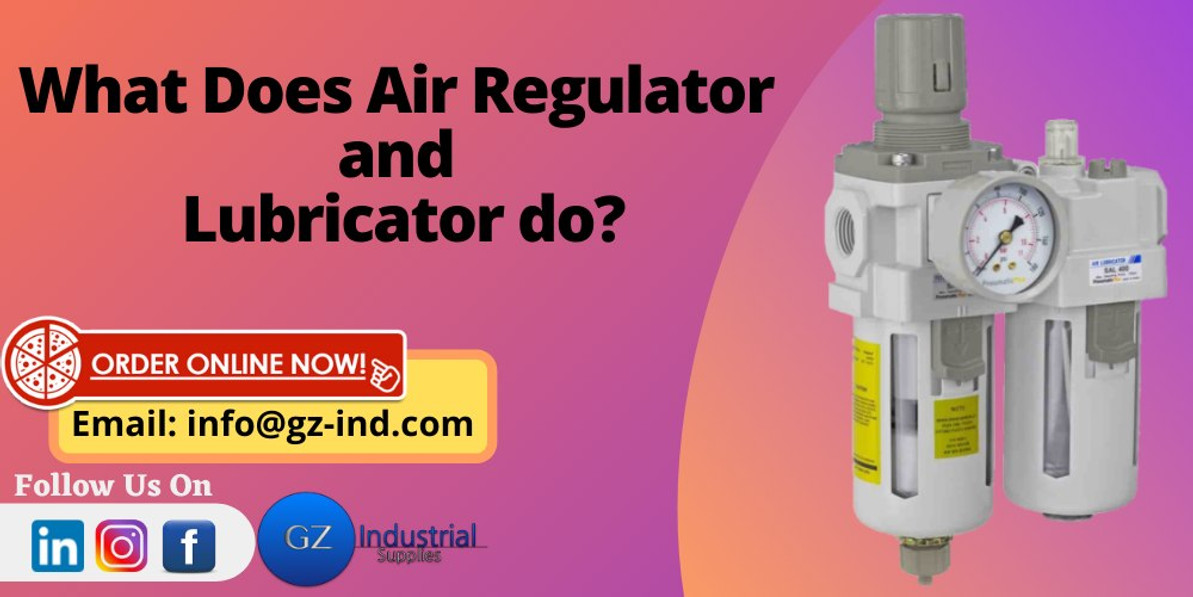What Does air regulator and lubricator do?
Air leaving a compressor is hot, dirty, and wet—which can damage and shorten the life of downstream equipment, such as valves and cylinders. Before air can be used, it needs to be filtered, regulated, and lubricated. This article answers the question of what does air regulator and lubricator do?
An airline filter cleans compressed air. It strains the air and traps solid particles (dust, dirt, rust), and separates liquids (water, oil) entrained in the compressed air. Filters are installed in the airline upstream of regulators, lubricators, directional control valves, and air-driven devices such as cylinders and air motors.
Airline filters remove contaminants from pneumatic systems, prevent damage to equipment, and reduce production losses due to contaminant-related downtime. Downtime in an industrial plant is expensive; often it is the result of a contaminated and poorly maintained compressed air system.
Selecting the proper filter size for any application should be done by determining the maximum allowable pressure drop, which the filter can cause. The pressure drop can be determined by referring to flow curves provided by the manufacturer.
There are three types of filters: general-purpose, Coalescing (oil removal), and Vapor removal. General Purpose is used to remove water and particles, Coalescing to extract oil, and Vapor removal to remove oil vapor and odor.
Pressure regulators reduce and control fluid pressure in compressed air systems. Regulators are also frequently referred to as PRVs (pressure-reducing valves). Optimally, a pressure regulator maintains a constant output pressure regardless of variations in the input pressure and downstream flow requirements. In practice, the output pressure is influenced to some degree by variations in primary pressure and flow.
Use as pressure regulators to equipment.
Pressure regulators are used to controlling pressure to air tools: such as impact wrenches, blowguns, air gauging equipment, air cylinders, air bearings, air motors, spraying devices, fluidic systems, air logic valves, aerosol lubrication systems, and most other fluid power applications.
Regulators have a control spring that acts on a diaphragm to regulate the air pressure. The rating of this control spring determines the pressure adjustment range of the regulator. General-purpose regulators are available in relieving or non-relieving types. Relieving regulators can be adjusted from high pressure to low pressure. Even in a dead-end situation, relieving regulators will allow the excess downstream pressure to be exhausted; this causes a loud hissing sound which is perfectly normal. Non- relieving regulators, when similarly adjusted, will not allow the downstream pressure to escape. The trapped air will need to be released somehow, e.g., by operating a downstream valve.
Downstream equipment flow and pressure requirements must be determined to properly select the size of the correct regulator for the application. Manufacturers offer flow characteristics charts on their products to help chose the proper regulator.
Acts as Lubricator
A lubricator adds controlled quantities of oil into a compressed air system to reduce the friction of moving components.
Most air tools, cylinders, valves, air motors, and other air-driven equipment require lubrication to extend their useful life. An airline lubricator solves the problems of too much or too little lubrication that arise with conventional lubrication methods such as a grease gun or oil. Once the lubricator is adjusted, an accurately metered quantity of lubricant is supplied to the air-operated equipment, and the only maintenance required is a periodic refill of the lubricator reservoir. Adding lubrication to a system also “washes away” compressor oils that travel through the system in vapor form. Mineral oils added to the system prevent synthetic compressor oil build-up on system components. When lubricators are not used in a system, installing a coalescing filter to remove compressor oil aerosols is essential.
Types of airline Lubricators
There are two types of airline lubricators: Oil-Fog for heavy applications such as single tools, cylinders, valves, and Micro-Fog for multiple applications, several cylinders or valves. In oil-fog lubricators, all the oil droplets seen in the sight dome are added directly into the airflow; this results in relatively large oil droplets passing downstream. In micro-fog lubricators, the oil droplets caught in the sight dome are atomized and collected in the area above the oil in the bowl. The smaller, lighter particles are drawn into the airflow and pass downstream. As a result, typically, only 10% of the oil seen as drops in the sight dome is passed downstream.
The selection of lubricators is by the size of the downstream flow requirements. It is crucial to analyze airflow use. After determining how much airflow is needed, then chose a lubricator. Manufacturers’ curves will be similar to the one shown.
Recent Posts
-
Top 10 Hand Tool Brands for Professionals
Introduction When it comes to professional hand tools, quality, durability, and reliability are para …Apr 23, 2025 -
HOW DOES CORROSION INHIBITOR WORK
Introduction Corrosion has posed a lot of problems to various companies and industries; by interfer …Apr 22, 2025 -
The Ultimate Guide to Understanding the Difference Between Ethylene Glycol and Propylene Glycol
Introduction Glycols are versatile compounds widely used across various industries, from automotive …Apr 16, 2025





